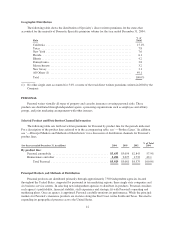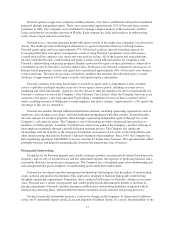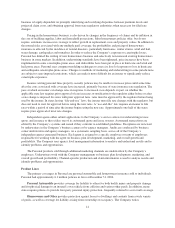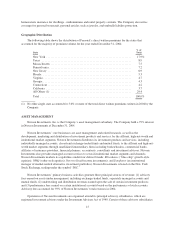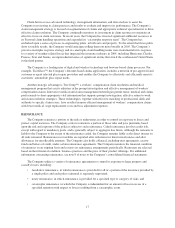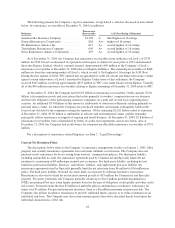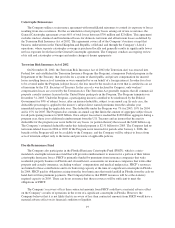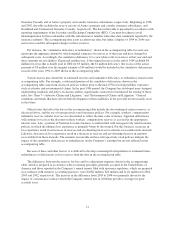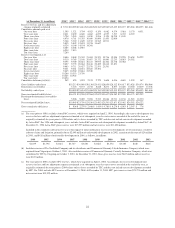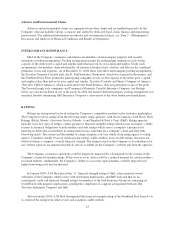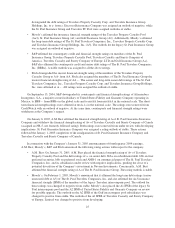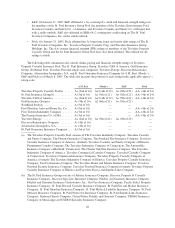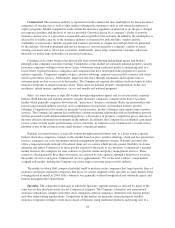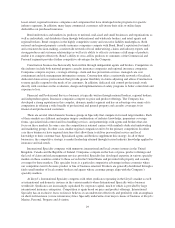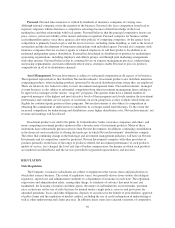Travelers 2004 Annual Report Download - page 32
Download and view the complete annual report
Please find page 32 of the 2004 Travelers annual report below. You can navigate through the pages in the report by either clicking on the pages listed below, or by using the keyword search tool below to find specific information within the annual report.RESERVES
Claim and claim adjustment expense reserves (loss reserves) represent management’s estimate of ultimate
unpaid costs of losses and loss adjustment expenses for claims that have been reported and claims that have been
incurred but not yet reported.
Management continually refines its reserve estimates in a regular ongoing process that includes review of
key assumptions, underlying variables and historical loss experience. The Company reflects adjustments to
reserves in the results of operations in the periods in which the estimates are changed. In establishing reserves,
the Company takes into account estimated recoveries for reinsurance, salvage and subrogation. The reserves are
also reviewed regularly by a qualified actuary employed by the Company.For additional information on the
process of estimating reserves and a discussion of underlying variables and risk factors, see “Item 7—
Management’s Discussion and Analysis of Financial Condition and Results of Operations—Critical Accounting
Estimates.”
The process of estimating loss reserves involves a high degree of judgment and requires the consideration of
a number of variables. These variables (discussed by product line in the previously mentioned “Critical
Accounting Estimates” section) are affected by both internal and external events, such as changes in claims
handling procedures, inflation, judicial trends and legislative changes, among others. The impact of many of
these items on ultimate costs of loss and loss adjustment expenses is difficult to estimate. Reserve estimation
difficulties also differ significantly by product line due to differences in the underlying insurance contract (e.g.,
claims made versus occurrence), claim complexity, the volume of claims, the potential severity of individual
claims, determining the occurrence date for a claim, and reporting lags (the time between the occurrence of the
insured event and when it is actually reported to the insurer). Informed judgment is applied throughout the
process.
The Company derives estimates for unreported claims and development on reported claims principally from
actuarial analyses of historical patterns of loss development by accident year for each type of exposure and
market segment. Similarly, the Company derives estimates of unpaid loss adjustment expenses principally from
actuarial analyses of historical development patterns of the relationship of loss adjustment expenses to losses for
each line of business and type of exposure. For a description of the Company’s reserving methods for asbestos
and environmental claims, see “Item 7—Asbestos Claims and Litigation,” and “Environmental Claims and
Litigation.”
Discounting
Included in the claims and claim adjustment expense reserves in the consolidated balance sheet are certain
reserves discounted to the present value of estimated future payments. The liabilities for losses for some long-
term disability payments under workers’ compensation insurance and workers’ compensation excess insurance,
which totaled $2.06 billion and $1.33 billion at December 31, 2004 and 2003, respectively, have been discounted
using rates of 3.5% to 5.0%. Reserves related to certain fixed and determinable asbestos-related settlements,
where all payment amounts and their timing are known, were discounted using a range of interest rates from
2.3% to 5.5% and totaled $48 million and $445 million at December 31, 2004 and 2003, respectively. Reserves
for certain assumed reinsurance coverage acquired in the merger, discounted using rates of 5.0% to 7.5%, were
$116 million at December 31, 2004.
Other Factors
The table on page 22 sets forth the year-end reserves from 1994 through 2004 and the subsequent changes in
those reserves, presented on a historical basis. The original estimates, cumulative amounts paid and reestimated
reserves in the table for the years 1994 through 2003 have not been restated to reflect the acquisition of SPC in
2004. The table includes SPC reserves at December 31, 2004.
The original estimates, cumulative amounts paid and reestimated reserves in the table for the years 1994 to
2001 and 1994 to 1995 have also not been restated to reflect the acquisition of Northland and Commercial
20




